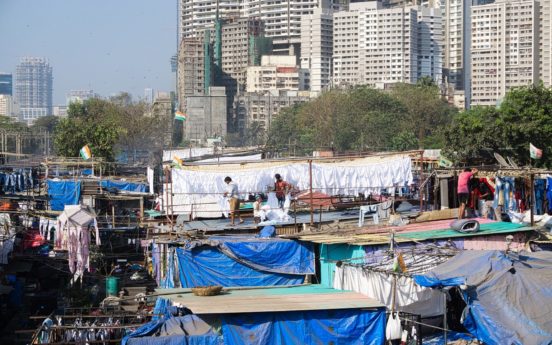Amidst almost unstoppable contagion, many have hung their hopes on heat and humidity as a potential defence against contracting COVID-19. In the early months of the pandemic studies of SARS-CoV-2 suggested that the virus is transmitted less efficiently in higher temperatures or at higher rates of humidity, leading to encouraging newspaper headlines around the world, from London to Jakarta. ‘Everybody hopes for seasonality,’ one US epidemiologist told the New York Times in May 2020, even as comparative reviews of research concluded that summer temperatures might slow but would not halt the transmission of the coronavirus.
Against the backdrop of rising global temperatures, however, the relationship between heat and contagion demands closer scrutiny.
In much of the world heat and humidity are far from benign. Seasonal temperature highs – equated with either summertime, dry, or rainy seasons – continue to break annual records, in what are localised symptoms of global heating. The combination of this extreme heat with extreme humidity is becoming more widespread and more severe. Cities present unique heat-health risks. The combination of a high-density population and a heavily built environment, the extensive use of asphalt and concrete in construction, and the lack of green space create an urban heat island effect that can add as much as 12°C to average recorded temperatures (Dawson 2017; CIESIN 2013).
Rising temperatures in cities have led urban planners and policy makers to develop new frameworks for action on heat, with the aim of reducing the effects of heat-related illnesses (heat exhaustion, heat stroke) on public health and the economy. Yet the effects of extreme heat on cities is uneven. Modulated by both explicit and implicit politics, the particular patterning of urban growth, its relationship to topography and the building materials used, unequal financial flows, and patchy networks of transport, health, and utilities provision has created particular micro-geographies of heat-health risk. Exposure and vulnerability intersect with gender and socioeconomic difference, increasing the likelihood of negative impacts on low income or marginalised groups. In cities across the Global South these are the grounds for what — in other contexts — the medical anthropologist Alex Nading (2020) has called a thermal politics of life and death, or a ‘thermal necropolitics.’
This year, heatwaves around the world will overlap with the spread of a novel coronavirus, and interventions intended to slow the pandemic will interact with interventions intended to reduce the risk of heat illness. Among those at the forefront of this nexus of heat and pandemic risk are those living in in high-density urban environments across the global tropics, from Southeast Asia to South Asia and sub-Saharan Africa; in particular on those who find themselves confined to homes with poor thermal insulation and little ventilation, and with limited access to mains electricity, water, and cooling green-infrastructures.
As the pandemic evolves, there is mounting concern about the specific impacts on people living and working in these ‘off grid’ cities (e.g. SSHAP 2020). Scholars have begun to identify the COVID-19 pandemic as a uniquely urban crisis that brings to the forefront the politics of urban governance, spatial inequality and austerity in the South (e.g. Saleem and Anwar 2020; Lancione and Simone 2020a; 2020b). How do these politics intersect with rising temperatures? And how will the combined effects of heat and the COVID-19 pandemic response impact the urban poor?
Our new research project, ‘Cool Infrastructures’ – housed at the University of Edinburgh, with partners in Yaoundé (Cameroon), Karachi (Pakistan), Hyderabad (India), and Jakarta (Indonesia) – was conceptualized as a comparative attempt to understand how marginalised urban residents find ways to cool themselves and their homes when temperatures in their cities rise. In these cities heat disproportionately impacts the poorest residents, in particular those living in densely populated, low-income settlements. Here, levels of exposure to extreme heat intersects with vulnerabilities and capacities as a result of socially constructed norms, roles, attitudes, and gender relations, as well as with socioeconomic status and forms of labour, to produce highly specific risk profiles and risk management strategies
As we began to organize ourselves in the months leading up to the project’s April 2020 start date, the novel coronavirus was also spreading rapidly across the globe. A pandemic was not something we had factored into our research and yet it had obvious implications for the project; empirically, methodologically, and conceptually. Our initial planning discussions quickly turned to thinking through collectively what the temporal coincidence of heatwaves that were anticipated in the next few months in many of our field sites and the COVID-19 pandemic meant. In this essay, we present some preliminary reflections, hoping to elicit further feedback from the broader research community.
Biosecurity meets Climate Security
Little is yet known about how exactly the dynamics of heat and humidity interact with measures to slow infection rates of SARS-CoV-2. But we do know that people living in high- density, income-poor neighbourhoods will be highly exposed and vulnerable to both threats and their compound effects. For those people whose livelihoods depend on movement, social contracts, and the street, a heat season with COVID-19 presents a high-risk trifecta of vulnerability, exposure, and hazard.
One way of understanding and analysing the relationship between heat and contagion is to examine the different kinds of governance interventions they generate. The responses of governments and nongovernmental organisations to the outbreak of an infectious disease on the one hand and the ongoing impact of rising global temperatures on the other reflect different modalities of attempts to govern, care for and secure the health and safety of human populations. ‘Biosecurity interventions’ (Lakoff and Collier 2008) coalesce around threats to human populations from harmful biological agents. Climate security interventions (Dalby 2013, 2014; MacDonald 2013; Oels et al 2014) coalesce around threats from extreme weather events and rapid environmental or ecological change. Both biosecurity and climate security interventions are accompanied by considerable debate about what these threats look like, how they can be known or understood, what the best kind of intervention is, and who is responsible for it amongst scientific communities, policy makers and politicians.
Today, efforts to secure the health of populations from the COVID-19 pandemic, extreme weather, and climate change are shaping different kinds of intervention, across fields as diverse as public health, humanitarian aid, and urban design. When these interventions overlap, they involve trade-offs across arenas and scales of governance. These are not only negotiations about knowledge. They are also inherently political processes with decisions shaped by specific kinds of valuation and judgement. Consequently, particular populations and concerns become visible while others are rendered invisible. One inevitable outcome of this is that some types of risk are deemed more dangerous or important than others; the other is that the health of some groups of people are likely to take precedence over the health of others.
Repeatedly, we find biosecurity interventions working against or counteracting climate security interventions. We can see this, most clearly, perhaps, in the relationship between COVID-19, traffic pollution, and urban air quality. Lockdown restrictions around the world created a widely observed drop in urban traffic and dramatic improvements in air quality. However, attempts to promote sustainable public transportation as a public good (by increasing the use of buses or metros) are now complicated by guidance on physical distancing, prompting fears of a post-lockdown rise in private transportation and pollution. These fears are borne out by recent reports of rising nitrogen dioxide levels in post-lockdown European cities. In a different context, tensions between biosecurity and climate security were also evident in struggles to secure the early release of prison populations across sub-Saharan Africa. In national debates, anxieties about the epidemiological threat that newly release prisoners presented to the general public were weighed against the risks of overheating and contagion that overcrowded and poorly ventilated jails presented to prisoners themselves. Such debates offer a powerful illustration of how trade-offs between biosecurity and climate security are, fundamentally, decisions over life itself.
These contradictions play out particularly visibly in the response to COVID-19 and heatwaves in high-density, low-income urban settlements.
Poverty, Density, Heat
Attempts to understand the health needs and health-seeking behaviour of people living in high-density urban environments reveal data gaps, urban interdependencies, specific patterns of vulnerability, as well as forms of local organisation that are all significant in understanding the impacts of COVID-19 (Wilkinson 2020). In southern cities it is not density per se that makes urban populations particularly susceptible to the spread of the virus, but density coupled with insecurity. From Karachi and Hyderabad, to Jakarta and Yaoundé, high levels of residential density are coupled with specific patterns of urban poverty. These include high levels of income insecurity, a lack of social protections, and poorly serviced infrastructures for water, sanitation, and electricity – partly as a result of cuts in public spending that followed programmes of structural adjustment or austerity policies. Put simply, there is a significant difference between prosperous dense places, where people have the materials and means to self-isolate or work remotely, and income-poor dense places, where multifamily households are crammed into living spaces of between 20 and 80 square yards, and where physical proximity is inescapable.
In October 2019, one month before the first reported case of a novel Coronavirus, The Jakarta Post reported that temperatures of 36.5 degrees was driving hundreds of people per day to visit community health centres, complaining about hot weather and dehydration. Six months later people living in cities across the Global South were confronted the twin challenge of managing a pandemic and managing the heat. Consider what we already know about the incidence of extreme heat events. In June 2015 temperatures in Karachi – where an estimated 12.4 million people (62 per cent of the city’s population) live in informal settlements – rose to 44.8 Celsius with over 1000 deaths recorded in 10 days. At the heatwave’s peak on June 20th, the heat index had reached 66 Celsius. Increased demand for energy led to prolonged power outages, and the temperature placed further pressure on already limited public water supplies. The effects were particularly pronounced in high density areas where narrow lanes or congested built environments curtailed wind circulation.
Measures to slow the pandemic have made enormous dents in the incomes of millions of low-income urban residents. The well-documented impact of India’s national lockdown and a collapse of informal urban economies – offers a sharp illustration of the ways that the pandemic response (a risk mitigation strategy for the coronavirus) can amplify other risks, including food insecurity and heat illness, by exacerbating social and economic inequality.
Maintaining social distance – the dominant modality of slowing the spread of the COVID-19 infection – for those who remain in high-density urban environments is challenging. So too is reducing the temperature of a body gripped by fever in a poorly ventilated, overheating room. As temperatures rose over the past two months in South Asia, for example, many people – including the healthy, the sick, and their carers – have been confined to indoor environments; from homes and wards, to dormitories and prisons. Meanwhile, those classified as essential workers and those for whom work is a precarious but essential source of income have been compelled to keep labouring in the heat. As rates of infection increase, the risks of exposure to extreme heat amongst these urban residents will be coupled with new limits on their capacity to search for cooler communal or public places, and new limits on their ability to pay for essential, and heat-managing, goods and services, including electricity, water and food.
The combined effect of heat, COVID-19 pandemic response measures, income poverty, and population density on infection and death rates remains unclear. But what seem clear is that it is creating unprecedented challenges for public health institutions, local authorities, and national governments. To date, however, the policy responses to COVID-19 and to extreme heat have contradicted each other, creating paradoxes of governance and infrastructure (e.g. Howe et al 2017).
Paradoxical Pulls
Policy responses to COVID-19 hinge on limiting social contact or subjecting both the sick and the healthy to forms of confinement. By contrast, city level heat action plans (like those drawn up by urban authorities across South Asia) prior to the pandemic hinge on contrasting principles. The measures they introduce – from the addition of extra water facilities in high-risk areas to the provision of public cooling centres – actually increase social contact.
COVID-care and heat-care thus pull the vulnerable in opposite directions. One involves social distancing and degrees of isolation, the other largely necessitates forms of public gathering. Public water taps, for example, may still be cool spots in a heatwave but they will also now be hot spots of potential community transmission. Emergency cooling centres may be important for alleviating the risk of heat stress but they now risk exposing people to infection.
These paradoxes have temporal as well as spatial dimensions. The timescales for biosecurity interventions are different than those for climate security. The outbreak of COVID-19 is an acute condition. Contagion is measured in days: in the stability or decay rates of the novel coronavirus on different surfaces or aerosols, and its incubation period (e.g. van Doremalen et al 2020). The COVID-19 pandemic response, however, is set to have a chronic impact on global incomes and inequality, with the effects on the capacity of urban populations to withstand changes in heat and humidity potentially worsening over the coming months and years.
How will these seemingly paradoxical forms of governance be resolved? If self-isolation and quarantine increase the risk of overheating, what other kinds of interventions may be required to ensure people can keep cool in a pandemic? Some responses are already emerging. The Global Heat-Health Information Network – an international, independent group of scientists, policy makers and planners established by the World Health Organisation and World Meteorological Organisation – directly addressing the contradictions in public health protocols around heat and COVID-19 by developing specific clarifications and recommendations, including for informal settlements. Meanwhile, in cities like Mumbai, architects and designers are working in collaboration with community based organisations to develop proposals for building amidst contagion and heat; integrating recommendations for social distance, cool air flow, and ventilation into new plans for low-income housing. But how will planners and local authorities manage these overlapping pressures? What kinds of other political and economic considerations will shape their implementation? And, as policy makers and practitioners refine their interventions, what kind of measures will be people be taking themselves?
Compounding Uncertainty
Just as heatwaves are a prominent source of risk in a changing climate, so is uncertainty. The issue is not just that extreme heat is bad or dangerous but that its effects are compounded by other unexpected or unanticipated events (Zscheischler et al 2018; Phillips et al 2020).
Extreme heat coupled with water scarcity or conversely unseasonal rain can exacerbate the effects. One way of understanding the risks facing people living in high-density, low-income urban settlements is to see them as ‘multidimensional’; simultaneously about health, the environment, technology, and infrastructure (e.g. SHAAP 2020). But the contours of risk are also shaped by specific urban histories, politics, economies, materialities, and practices. The compounding effects of heat and COVID-19 on cities in the Global South are second-order effects of processes of urban development, patterns of investment, construction, and employment. Understanding the compound effects of heat and COVID-19 in cities across the Global South demands an epidemiology that can account for both for the extreme uncertainty of the pandemic, as well as the inequalities, pervasive insecurities, and uncertainties of ‘late industrialism’ (Fortun 2014).
In seeking to reduce the magnifying effects of heat governance on health governance and vice versa, we need to find ways of bringing social science insights to bear on attempts to intervene in the lives of others. If, as Jaideep Gupte (2020) hopes, the coronavirus pandemic holds out the promise of ‘course correcting’ dominant approaches to urban planning and infrastructure, perhaps leading to interventions that are more people-centred, then we need to understand the compromises and trade-offs being made between biosecurity and climate security. We need to address, more urgently than ever, how people in low-income, high-density urban contexts manage heat, and navigate multiple and converging hazards in constrained and contradictory circumstances. Over the next three years we will be examining this question. How we do so in a pandemic is the next challenge, demanding innovations in research methodologies and practices.
This is a repost from Somatosphere.
“Cool Infrastructures” is a three year project funded by the UK’s Economic and Social Research Council through the Global Challenges Research Fund, a £1.5 billion UK Government scheme to support cutting edge research and global impact towards the Sustainable Development Goals. This article was written by the following project investigators:
Nausheen Anwar is Professor of City and Regional Planning and Director of the Karachi Urban Lab at the Institute of Business Administration, Karachi.
Sulfikar Amir is Associate Professor of Science, Technology, and Society at Nanyang Technological University, Singapore.
Jamie Cross is a Senior Lecturer in Social Anthropology at the University of Edinburgh.
Daniel Friedrich is a Lecturer in Engineering at the University of Edinburgh.
Rachel Harkness is a Lecturer in Design Ecologies at the University of Edinburgh.
Aalok Khandekar is Assistant Professor of Anthropology/ Sociology at Department of Liberal Arts, Indian Institute of Technology, Hyderabad.
Anindrya Nastiti is a Lecturer in Civil Engineering at the Bandung Institute of Technology.
Marie Morelle is Maîtresse de Conférences in the Geography Faculty at à l’Université Paris 1 – Panthéon Sorbonne, Paris and a visiting researcher at Fondation Paul Ango Ela, Cameroon.
Elspeth Oppermann is a Researcher in Geographer at Ludwig Maximillian’s University Munich.
References Cited
CIESIN, 2013 Global Urban Heat Island (UHI) Data Set, 2013, Center for International Earth Science Information Network – Columbia University, 2016, NASA Socioeconomic Data and Applications Center (SEDAC): Palisades, NY.
Dalby, S., 2013. Biopolitics and climate security in the Anthropocene.Geoforum, 49, pp.184-192.
Dalby, S., 2014. Rethinking geopolitics: Climate security in the Anthropocene. Global Policy, 5(1), pp.1-9.
Dawson, A. 2017. Extreme Cities. London: Verso
van Doremalen N, Bushmaker T, Morris DH, et al. Aerosol and Surface Stability of SARS-CoV-2 as Compared with SARS-CoV-1. The New England Journal of Medicine. 2020 Apr;382(16):1564-1567. DOI: 10.1056/nejmc2004973.
Fortun, K. “From Latour to late industrialism,” HAU: Journal of Ethnographic Theory 4, no. 1 (Summer 2014): 309-329.
Gupte, J. (2020) Covid-19: A Course Correction for Safer Cities? UK Collaborative on Development Research. Available at: www.ukcdr.org.uk/covid-19-a-course-correction-for-safer-cities/
Howe, C., Lockrem, J., Appel, H., Hackett, E., Boyer, D., Hall, R., Schneider-Mayerson, M., Pope, A., Gupta, A., Rodwell, E., Ballestero, A., Durbin, T., el-Dahdah, F., Long, E., and Mody, C. 2016. Paradoxical infrastructures: Ruins, retrofit, and risk. Science, Technology, & Human Values, 41(3), pp.547-565.
Lancione, Michele and Simone, AbdouMaliq (2020a). “Bio-austerity and Solidarity in the Covid-19 Space of Emergency – Episode One.” Society and Space. Available at: www.societyandspace.org/articles/bio-austerity-and-solidarity-in-the-covid-19-space-of-emergency
Lancione, Michele and Simone, AbdouMaliq (2020a). “Bio-austerity and solidarity in the covid-19 space of emergency – Episode Two”. Society and Space. Available at: www.societyandspace.org/articles/bio-austerity-and-solidarity-in-the-covid-19-space-of-emergency-episode-2
Lakoff, A. and Collier, S.J. eds., 2008. Biosecurity interventions: global health and security in question. Columbia University Press.
Oels, A., Stripple, J. and Bulkeley, H., 2014. Climate security as governmentality: From precaution to preparedness. Governing the Climate, pp.197-216.
Nading, A. 2017 Heat in Anthropocene Unseen. Cymene Howe and Anand Pandian Eds. 2020 Earth, Milky Way: Punctam Books
McDonald, M., 2013. Discourses of climate security. Political Geography, 33, pp.42-51.
Raymond, C., Matthews, T. and Horton, R.M., 2020. The emergence of heat and humidity too severe for human tolerance. Science Advances, 6(19), p.eaaw1838.
Phillips, C.A., Caldas, A., Cleetus, R. et al. Compound climate risks in the COVID-19 pandemic. Nat. Clim. Chang. (2020).
Saleem, A and Anwar, N 2020. Urban life in the Covid-19 Space of Emergency: Field Notes from Karachi. Available at: www.identitiesjournal.com/the-viral-condition-virtual-symposium/urban-life-in-the-covid-19-space-of-emergency-field-notes-from-karachi
Social Science in Humanitarian Action Partnership (2020) Key Considerations: COVID-19 in Informal Urban Settlements, SSHAP. Available at: https://opendocs.ids.ac.uk/opendocs/handle/20.500.12413/15185
Wilkinson, A. 2020. The impact of Covid-19 in informal settlements: Are we paying enough attention? Available at: www.ids.ac.uk/opinions/the-impact-of-covid-19-in-informal-settlements-are-we-paying-enough-attention/
Zscheischler, J., Westra, S., van den Hurk, B.J.J.M. et al. 2018. Future climate risk from compound events. Nature Clim Change 8, pp.469–477.










Comments by